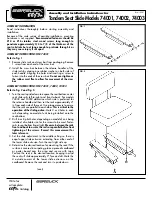
Arrow Manual
Glossary
246
Line Level Refers to the voltages used by audio devices such as mixers, signal
processors, tape recorders, and DAWs. Professional audio systems typically utilize
line level signals of +4 dBm (which translates to 1.23 volts), while consumer and
semiprofessional audio equipment typically utilize line level signals of -10 dBV (which
translates to 0.316 volts).
Low Cut Filter An equalizer circuit that cuts signal below a particular frequency. Same as
“high pass filter.”
Mic Level Refers to the very low level signal output from microphones, typically around 2
millivolts (2 thousandths of a volt).
Mic Preamp The output level of microphones is very low and therefore requires specially
designed mic preamplifiers to raise (amplify) their level to that needed by a mixing
console, tape recorder, or digital audio workstation (DAW).
Mute “Turn off the signal.” Mute stops the signal from being routed.
Native Refers to computer-based digital audio recording software controlled by the
computer’s onboard processor, as opposed to software that requires external hardware to
run.
OS Acronym for Operating System. The OS is the software used to control the computer
hardware, such as OS X (Mac) and Windows 10 (PC).
Pan Abbreviation for “Panorama” or “Panoramic.” A pan control determines a
monophonic signal’s positioning in the stereo field.
Patch Bay A passive, central routing station for audio signals. In most recording studios,
the line-level inputs and outputs of all devices are connected to a patch bay, making it
an easy matter to re-route signal with the use of patch cords.
Patch Cord A short audio cable with connectors on each end, typically used to
interconnect components wired to a patch bay.
PDF Acronym for “Portable Document Format.” PDF is the standardized file format used
for distribution of documentation in electronic form. Various applications can open PDF
files; one such “reader” application is available for free at www.adobe.com.
Plug-In Software components that are added to host software applications to enhance
their functionality and/or performance.
Powered Plug-Ins High-quality audio processing plug-ins, developed and sold by
Universal Audio, that run exclusively on UAD DSP accelerator products.
Quantization Noise A form of digital distortion caused by mathematical rounding-off
errors in the analog to digital conversion process. Quantization noise can be reduced
dramatically by dithering the digital signal. (See “Dither“)
Realtime UAD Processing Universal Audio’s DSP + FPGA technology that enables
UAD Powered Plug-Ins to run with latencies in the sub-2ms range on input with UA’s
Arrow and Apollo line of audio interface models. Realtime UAD processing provides the
ultimate sonic experience while monitoring and/or tracking. Realtime UAD processing is
a special function that is available only within the Apollo/Arrow Console application.
Содержание Arrow
Страница 272: ...www uaudio com ...
















































